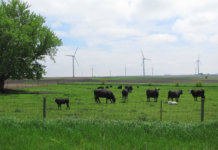 The U.S. Department of the Interior (DOI) and California Natural Resources Agency have released a long-awaited draft plan to guide renewable energy development and conservation in the California desert. However, although the agencies say the land-use plan will help encourage and expedite clean energy projects, the California wind industry has raised some serious concerns.
The U.S. Department of the Interior (DOI) and California Natural Resources Agency have released a long-awaited draft plan to guide renewable energy development and conservation in the California desert. However, although the agencies say the land-use plan will help encourage and expedite clean energy projects, the California wind industry has raised some serious concerns.
According to the DOI, the draft Desert Renewable Energy Conservation Plan (DRECP) is a landscape-scale blueprint that is the result of an extensive public participation process over the past several years. Collaborators included the U.S. Bureau of Land Management, the U.S. Fish and Wildlife Service, the California Energy Commission, the California Department of Fish and Wildlife, conservation groups, renewable energy companies and other stakeholders.
"The president's Climate Action Plan calls for expanding clean, domestic energy on public lands to create jobs and cut carbon pollution," said Interior Secretary Sally Jewell when announcing the draft. "The draft plan � will help provide effective protection and conservation of the California desert important for wildlife, recreation, cultural preservation and other uses, while encouraging streamlined renewable energy development in the right places."
The public will have until January 2015 to provide additional comments on the draft plan, which covers more than 22 million acres in Imperial, Inyo, Kern, Los Angeles, Riverside, San Bernardino and San Diego counties. Both Jewell and John Laird, secretary of the California Natural Resources Agency, have said they look forward to more comments on the DRECP.
"Although the release of this draft plan is a milestone reached after years of collaboration and stakeholder input, we expect the draft plan to benefit from robust public participation," said Laird. "Public input is a critical part of the process and will help us develop the best-possible final plan."
Environmental groups the Natural Resources Defense Council (NRDC) and the Sierra Club seem eager to chime in on the draft DRECP.
In a statement, Helen O'Shea from the NRDC says, "This process has set an important and useful precedent, and we look forward to reviewing the document. If designed and administered correctly, this landmark effort can provide a blueprint for responsible renewable energy development while safeguarding the desert's special places and species."
Barbara Boyle, senior campaign representative for the Sierra Club, calls the plan "a promising step."
‘We are still analyzing the plan, and there will no doubt continue to be debate about where to site clean energy projects and how to best conserve areas important for wildlife, wilderness and recreation," says Boyle in a statement. "But we are hopeful that the DRECP will become a model for sustainable, well-sited development as our state continues its transition to clean energy."
The California Wind Energy Association (CalWEA), on the other hand, says it is disappointed with the draft plan and warns the DRECP could hinder most potential wind development in the state.
The draft DRECP offers several alternative approaches for meeting renewable energy and conservation goals. According to the DOI, each alternative proposes a different conservation design and configuration of lands available for renewable energy permitting.
Nancy Rader, executive director of CalWEA, says, "After years of trying to constructively engage in this process, we did not expect this plan to provide permitting efficiencies for wind energy. But it now appears that our worst fears are being realized: All five DRECP Plan Alternatives could end most wind energy development in California.
"If climate change is an "existential challenge,' as Governor [Jerry] Brown stated at the U.N. this week, then why is California aiming to put its best, carbon-free wind resources off limits? The strongest winds generate the cheapest power, and cost will affect public enthusiasm for addressing climate change."
According to CalWEA, the plan's alternative most favorable to wind energy (Alternative 2) purports to plan for some 5.8 GW of wind power through 2040 – which, coincidentally, compares to over 5,800 MW already operating in California. However, CalWEA says that alternative would preserve for exploration a very small fraction of the best wind resources in the desert region – the region containing most of the state's remaining commercially viable wind resources – leaving an insufficient area to find enough workable project sites to meet even that low target. The agencies' "Preferred Alternative" would accommodate even less wind energy, CalWEA continues.
The group notes that much of the state's best remaining wind resources reside on federal land managed by the Bureau of Land Management (BLM), where only three wind projects have been permitted over the past four years on the more than 15 million acres that agency manages in California. Some 27 new wind energy projects have been permitted on California private land by county governments in the same timeframe, CalWEA adds.
"The wind industry supports the kind of landscape-level planning that the DRECP is trying to accomplish and that the Department of the Interior is championing elsewhere," says Rader. "Unfortunately, the draft plan fails to properly evaluate the limited habitat impacts of wind energy. The process was never able to overcome its scientific shortcomings when it came to wind energy's interaction with the desert environment. For landscape-level planning to succeed, wind energy's compatibility with species, habitat and the environment will need to be more properly studied and understood.
"We are taking state and federal officials at their word that, with the release of this draft, much-needed dialogue can now occur and significant change is still possible before the plan becomes final," continues Rader. "While we expect to remain constructively engaged in this process, a plan that works for wind energy will unfortunately require the agencies to go back to the drawing board and recirculate a new plan."
The draft DRECP is available here, and the public comment period will run through Jan. 9, 2015.



